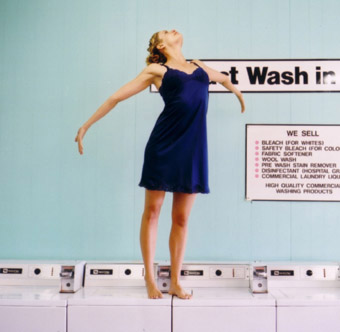Next Wave: From the everyday to pure effect
Jonathan Marshall: Dance Party, The Physical Story

Elissa Lee, The Physical Story
Choreographer Fiona Cameron is developing a distinctive, albeit piecemeal, aesthetic. Having danced with both Gideon Obarzanek's Chunky Move and Kate Champion's Force Majeur, Cameron is strongly drawn to the pedestrian humour and accessible comedy of the everyday which underlies much of her associates' work. Her latest piece, The Physical Story, begins in this vein.
We see a telephone surveyor (Sally Smith) moving from her kitsch but reassuring apartment, bedecked with porcelain statuettes, to her quietly maddening job, high above the stage, within the metal latticework of the theatre walls. We see an obsessive compulsive introvert (Elissa Lee) rearranging materials within her dwelling (a squat, perhaps?) and making awkward, darting journeys into the outside world, a hood pulled over her head. We see a tall, slightly camp black man (Earle Rosas) move into a room which he adorns with a poster of Marilyn Monroe. He settles into his tedious, potentially demeaning work behind a checkout stand, his eyebrows ever raised and pupils making swift stabs about the space as he observes the strange goings on of the urban community he has entered.
Cameron's attention, however, soon shifts elsewhere. Having established her characters and the familiar world which they inhabit through a smattering of gestures, words, pieces of costume and fragments of set, the straightforward dramatic situation quickly unravels. The movement becomes less and less everyday as we enter strange, abstract realms of physical awkwardness and imperfect attempts at physical contact or communion, with little or no preceding dramatic exposition to give these sequences a clear metaphoric import. To seen this as sign of arbitrariness in the allocation of dramatic significance would be ungenerous. Rosas' particularly beautiful, elongated, balletic poise rises above any potential dramaturgical imprecision to impart a strong sense of emotional and cultural ambiguity to his movement.
The style of the work thus moves from essentially straightforward dramatic physical theatre into something closer to the abstract European dance theatre of Anne Teresa de Keersmaeker, Alain Platel's Les Ballets C de la B or Abdelaziz Sarrokh's Hush Hush Hush (2Pac, Melbourne Festival 2001). Movement comes to function here in an imperious fashion, the strength of the image or the physical pose breaking through any narrative or dramatic conceit, to take us into the realm of pure affect.
Cameron begins The Physical Story using dance to represent conventional occurrences, but by the finale we see such unlikely images as Rosas, dressed in an elegant, form-fitting evening gown, tangoing with Lee, who is now relaxed and clothed in a trendy, body-hugging purple dress. First she, and then he leads. Movement becomes the language of dreams and desires, of fear and anxiety, ecstasy and frustration. The match between these 2 approaches to dance is imperfect, and it is disappointing that Smith was not also included in the final, ambiguously liberating duet. But Cameron is to be commended for daring to combine the intensely abstract with the painfully banal.
Dance Party, The Physical Story, choreographer/director Fiona Cameron, choreographers/performers Sally Smith, Elissa Lee, Earle Rosas, lighting Jen Hector, sound Byron Scullin; BMW Edge, Federation Square, Melbourne, May 24-26
RealTime issue #62 Aug-Sept 2004 pg. Onl






